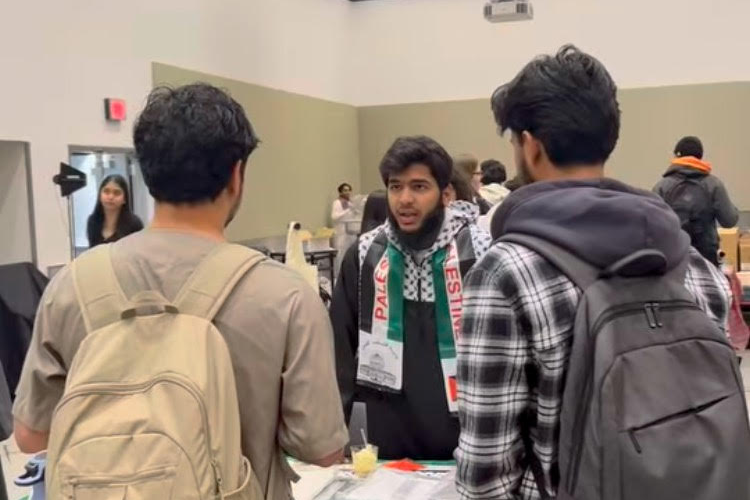For Antonio Ramirez, associate professor of history at Elgin Community College, his most prized possession is an eight-hour long audio CD of his late Mexican grandfather telling his life story.
Ramirez currently serves as director of the Chicagolandia project, which aims to document and preserve the oral and archival histories of Latinx suburban communities around Chicago, like that of Ramirez’s grandfather, in order to foster conversations about the future of Latinx communities.
Ramirez visited College of DuPage’s Health and Science Center this past Thursday to provide a broad history of Latinx migration and impact in the United States in celebration of Hispanic Heritage Month, which is celebrated annually from Sep. 15 to Oct. 15.
Ramirez began his presentation by explaining that most Latinx communities are situated in the suburbs of Chicago rather than the city itself. Ramirez explained that in the last 25 years, the Latinx population has increasingly shifted to the suburbs, making it the largest Latinx community in the Midwest.
“The Latino suburbs are the future of Latino people across the region,” he said. “and it’s the biggest population in the Midwest.”
He explained how many Latinx immigrants coming to America, particularly Venezuelan refugees escaping rapid inflation, are negatively and unjustly labeled. Ramirez strongly condemned those who perpetuate such stereotypes.
“They’re not illegal aliens,” he said. “They’re here legally seeking asylum. Some of these people are coming from some of the hardest imaginable situations, crossing thousands of miles. Then they show up in the United States and they’re called criminals and murderers.”
Jacqueline Alcantara, a health science major at College of DuPage, attended the event. As a Mexican-American, she was intrigued to know more about Latinx history in the United States. Like Ramirez, she acknowledged the divide in America between those who support and oppose immigration.
“I wanted to learn more about where my roots are from and learn about the history of Hispanics in the United States,” she said. “That’s what motivated me [to attend]. There’s a huge division between people being supportive of immigrants and then people against immigrants in the United States.”
Ramirez discussed how an influx of Mexican migrants fleeing the Mexican Revolution in the 1910s and 1920s predated the Great Depression. As a consequence, many native-born Americans accused Mexican immigrants of stealing jobs and causing the Depression.
“Whenever an economic depression happens,” he said, “people start to look around to see whose fault it is.”
This ultimately led to the Repatriation Act of 1929, which forcibly removed nearly 2 million American citizens and legal residents of Mexican ancestry and deported them to Mexico. Ramirez said those who were deported left behind property that was often stolen. The Act, which lasted until 1936, wiped out many Mexican communities from the American landscape.
Shortly after, demand for Latin American workers rose again. This led to the creation of the Bracero Program, which was initiated in 1942 and brought in numerous short-term contract laborers primarily from Mexico. Companies would also fly to Puerto Rico to recruit contract workers. The program was terminated in 1964.
“There was a massive deportation campaign in the 1950s of Mexican workers,” he said. “But if you were Mexican after that program particularly, and you wanted to come as a postal worker, you could still come to the United States. Did American businesses stop needing Mexican workers? No. American businesses kept hiring Mexicans. But instead of legal Bracero workers, now they’re undocumented. And they start to be called illegal.”
Alcantara was shocked to learn from the presentation how the U.S. government historically treated Latinx migrant workers as disposable.
“I think the most surprising thing that I learned from his presentation was when he was explaining how the United States government wanted Mexican immigrants to come into the United States to help improve the economy and help fill in the jobs that people weren’t interested in,” she said. “Then all of a sudden, when they were no longer needed, they forced them to leave.”
Ramirez asserted the importance of taking Latinx history into account in order to value the Latinx community as individuals with a rich culture and history and provide them with the resources they need to succeed.
“Valuing the Latino people who have helped support this economy, treating Latino people as all human beings who are contributing in the country means supporting their families,” he said. “It means finding a pathway to citizenship for people who have been here for a long time. We need to be able to build wealth, to go to school. Our language should be valued.”
Alcantara voiced the fact that many first-generation Americans do not know of their cultural history, and affirmed the need for educational institutions to better inform students on the histories and cultures of people around the world.
“Different races and ethnicities in the United States don’t get to learn their history in the United States, which I wish we did more of” she said. “I think it’s so important for [students] to learn about their roots and their history. The United States [is a] cultural country. And I think that’s what makes it unique.”
The Chicagolandia Oral History Project invites people of Latin American descent to share their familial and cultural stories, which can be submitted on their website.









